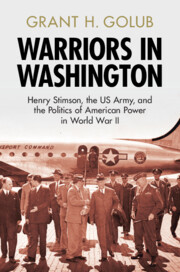Refine search
Actions for selected content:
15401 results in Military history
Chapter 4 - Serving the Patria
-
- Book:
- Emigrant Soldiers
- Published online:
- 05 June 2025
- Print publication:
- 26 June 2025, pp 73-92
-
- Chapter
- Export citation
Chapter 3 - Viva l’Italia!
-
- Book:
- Emigrant Soldiers
- Published online:
- 05 June 2025
- Print publication:
- 26 June 2025, pp 50-72
-
- Chapter
- Export citation
Chapter 10 - Epilogue
-
- Book:
- Emigrant Soldiers
- Published online:
- 05 June 2025
- Print publication:
- 26 June 2025, pp 223-232
-
- Chapter
- Export citation
Chapter 9 - Dictatorship, Occupation and Internment
-
- Book:
- Emigrant Soldiers
- Published online:
- 05 June 2025
- Print publication:
- 26 June 2025, pp 185-222
-
- Chapter
- Export citation
Figures
-
- Book:
- Emigrant Soldiers
- Published online:
- 05 June 2025
- Print publication:
- 26 June 2025, pp vi-vii
-
- Chapter
- Export citation
Chapter 2 - Refugees and Volunteers
-
- Book:
- Emigrant Soldiers
- Published online:
- 05 June 2025
- Print publication:
- 26 June 2025, pp 30-49
-
- Chapter
- Export citation
Chapter 5 - Trickeries and Broken Promises
-
- Book:
- Emigrant Soldiers
- Published online:
- 05 June 2025
- Print publication:
- 26 June 2025, pp 93-121
-
- Chapter
- Export citation
Chapter 8 - Isolation, Indifference and Suspicion
-
- Book:
- Emigrant Soldiers
- Published online:
- 05 June 2025
- Print publication:
- 26 June 2025, pp 165-184
-
- Chapter
- Export citation
Abbreviations
-
- Book:
- Emigrant Soldiers
- Published online:
- 05 June 2025
- Print publication:
- 26 June 2025, pp xi-xii
-
- Chapter
- Export citation
Copyright page
-
- Book:
- Emigrant Soldiers
- Published online:
- 05 June 2025
- Print publication:
- 26 June 2025, pp iv-iv
-
- Chapter
- Export citation
Index
-
- Book:
- Emigrant Soldiers
- Published online:
- 05 June 2025
- Print publication:
- 26 June 2025, pp 258-264
-
- Chapter
- Export citation
Bibliography
-
- Book:
- Emigrant Soldiers
- Published online:
- 05 June 2025
- Print publication:
- 26 June 2025, pp 233-257
-
- Chapter
- Export citation
Contents
-
- Book:
- Emigrant Soldiers
- Published online:
- 05 June 2025
- Print publication:
- 26 June 2025, pp v-v
-
- Chapter
- Export citation
Chapter 7 - Crazy with Joy!
-
- Book:
- Emigrant Soldiers
- Published online:
- 05 June 2025
- Print publication:
- 26 June 2025, pp 141-164
-
- Chapter
- Export citation
Chapter 1 - Sons of Sunny Italy
-
- Book:
- Emigrant Soldiers
- Published online:
- 05 June 2025
- Print publication:
- 26 June 2025, pp 1-29
-
- Chapter
- Export citation
Acknowledgements
-
- Book:
- Emigrant Soldiers
- Published online:
- 05 June 2025
- Print publication:
- 26 June 2025, pp viii-x
-
- Chapter
- Export citation

Warriors in Washington
- Henry Stimson, the US Army, and the Politics of American Power in World War II
-
- Published online:
- 23 June 2025
- Print publication:
- 10 July 2025

A Black Army
- Segregation and the US Military at Fort Huachuca, Arizona, 1941–1945
-
- Published online:
- 16 June 2025
- Print publication:
- 17 July 2025

Emigrant Soldiers
- Mobilising Italians Abroad in the First World War
-
- Published online:
- 05 June 2025
- Print publication:
- 26 June 2025
Chapter 3 - Preserving scratch
- from Part 2 - Mobilising resources for war
-
-
- Book:
- Mobilising the Australian Army
- Published online:
- 23 May 2025
- Print publication:
- 30 May 2025, pp 50-70
-
- Chapter
- Export citation
